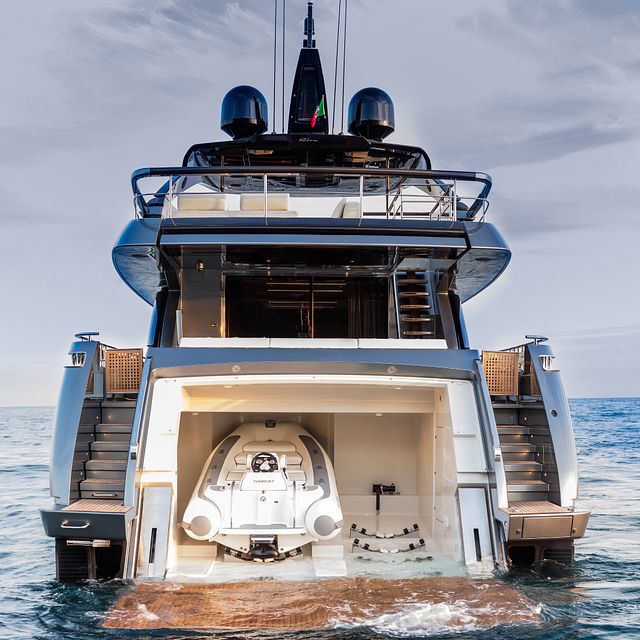Plastic ball bearings for overhead conveyor systems
Overhead conveyor systems are an excellent way to maximize the space being used within a factory. They make use of a space that would otherwise go totally unused, while at the same time making material handling processes more efficient. However, many overhead conveyor systems aren’t reaching their full potential by making use of polymer ball bearings. This blog will examine the different types of overhead conveyor systems, as well as the multitude of benefits polymer bearings provide over standard metal bearings.
What is an overhead conveyor system?
In the case of overhead conveyors, the name says it all: They’re conveyor systems that operate above workers and other equipment, utilizing overhead space that would otherwise remain empty. Overhead conveyors typically consist of a continuous chain circuit that runs through the entire track, carriers that are used to handle the material, and a motor in the case of electrically driven systems. The chain uses roller bearings to move along the track with minimal friction, and a take-up is used to maintain proper tension on the chain over the service life of the system.
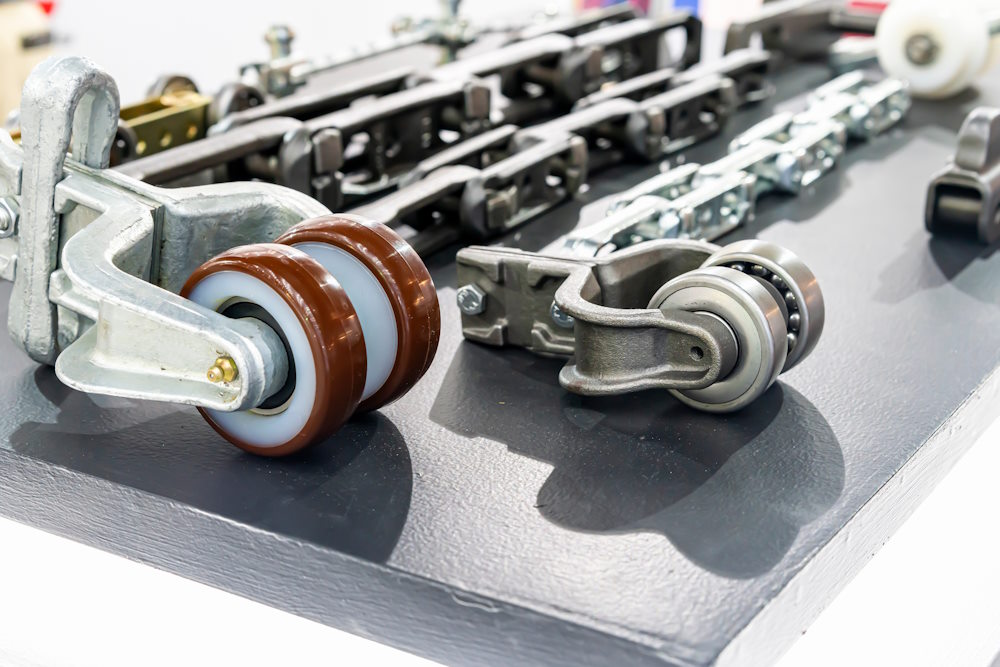
There are three major ways to differentiate overhead conveyor systems: whether the track is open or enclosed; whether the system is powered electrically or manually; and whether the materials move synchronously or asynchronously. However, there can be many smaller differences between systems as they’re often custom-made for specific applications.
Powered vs. free
Powered overhead conveyors utilize an electric motor to drive the system and move materials along the track. This is a very energy efficient means of powering the system, having near-negligible energy consumption. Powered systems can also be automated, which can be especially useful in factories that already implement automation in other areas.
Manually operated — often referred to as “free” — overhead conveyors require manual labor to move materials along the track. Free conveyors are most effective for large, heavy materials, especially if a high level of precision is necessary.
Combined “power and free” overhead systems also exist, which combine a powered track and a free track. The powered track pulls trolleys along the free track, which can be started and stopped at certain points with a blade stop. These are preferred for high volume systems that need a high level of reliability and durability — such as those in the automotive industry.
Open vs. enclosed track
The track of a conveyor system serves the same function whether open or enclosed — to act as a guide for the chain & materials being moved. However, open tracks are simpler to install and are capable of holding more weight per carrier than enclosed tracks. The advantage of enclosed tracks is added protection from environmental effects, which is especially useful in applications like painting that can damage the chain over time if left exposed. Typically, asynchronous systems are unpowered and synchronous systems powered, but there are exceptions.
Synchronous vs asynchronous
The way materials are moved along an overhead conveyor system can either be synchronous or asynchronous. Synchronous conveyor systems are those that keep all materials moving at the same rate, maintaining an even spacing between each material. Asynchronous is the opposite of this, where individual materials move separately from one another and don’t have even spacing.
What are the advantages of overhead conveyor systems?
There are a number of advantages that come along with integrating overhead conveyor systems in your warehouse, including space efficiency, employee safety, and system flexibility.
The biggest of these benefits is employee safety. By moving conveyor systems overhead, employees are able to work without the risk of moving materials hitting them or otherwise interfering with their work.
Another major benefit to using overhead conveyor systems is more efficient use of space. Instead of taking up significant floor space with a traditional conveyor system, an overhead system makes use of what would otherwise be unused space above the floor. This can allow operations to expand significantly while still operating within the same physical space.
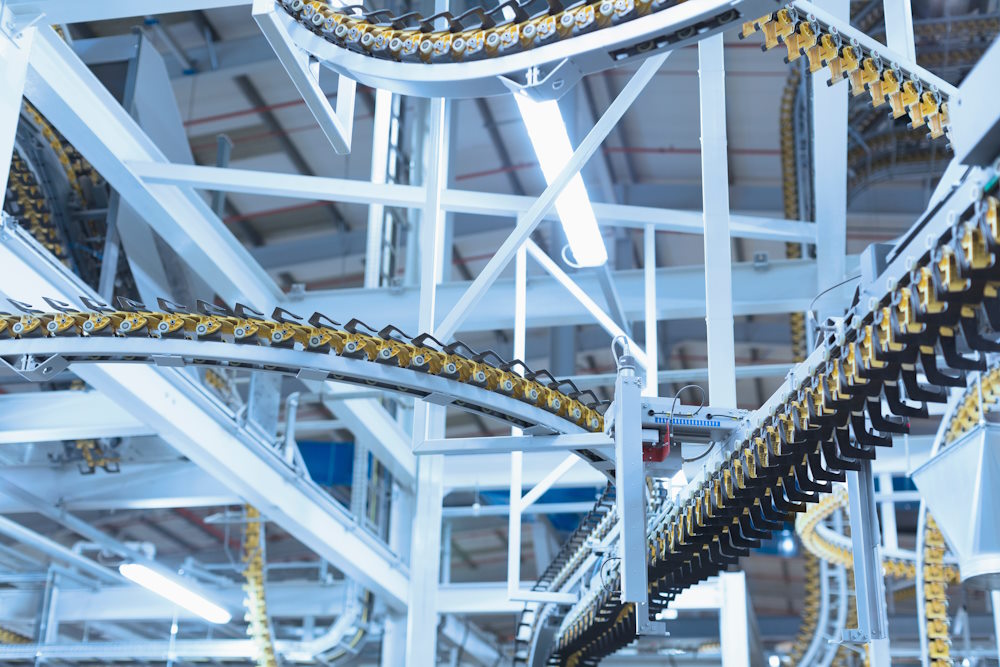
Finally, overhead conveyor systems offer a degree of flexibility that allows them to be adapted to work within nearly any material handling operation. With all the different types of overhead conveyors mentioned earlier, along with more unique custom solutions, there’s much more freedom to establish the perfect overhead system than with conventional floor conveyors.
Why use plastic ball bearings for overhead conveyors?
Ball bearings are the first choice when it comes to overhead conveyor systems because of their low coefficient of friction and small profile ideal for tight installation spaces. In many overhead conveyor systems, you’ll see metal ball bearings being used. This is primarily due to their high load capacity and resilience even in harsh conditions. However, metal bearings are not without their own drawbacks.
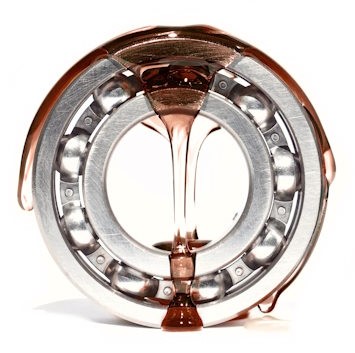 The biggest disadvantage that comes with metal ball bearings is the need for regular maintenance in the form of relubrication. This is already a time-consuming and costly task on its own, but it’s made even more so in overhead systems that are difficult to reach and properly maintain. Improper lubrication is already one of the leading causes of bearing failure, so anything that makes the relubrication process more difficult is best avoided when possible.
The biggest disadvantage that comes with metal ball bearings is the need for regular maintenance in the form of relubrication. This is already a time-consuming and costly task on its own, but it’s made even more so in overhead systems that are difficult to reach and properly maintain. Improper lubrication is already one of the leading causes of bearing failure, so anything that makes the relubrication process more difficult is best avoided when possible.
The easiest way to avoid the need for relubrication in bearings entirely is to use self-lubricating plastic ball bearings. These bearings are made of a tribologically optimized polymer blend that incorporates solid lubricants throughout the material, ensuring adequate and even lubrication across the entire bearing over the course of its service life.
Maintenance is only one source of cost savings when choosing plastic ball bearings over metal. Plastic ball bearings can be up to 40% cheaper than metal ones. This may seem like a minor difference when talking about small quantities, but the costs add up quickly when talking about the hundreds or potentially even thousands of bearings needed to outfit an entire overhead conveyor system.
Corrosion is another concern with metal ball bearings that needs to be taken into consideration. All hardened steel, even when specially coated, is susceptible to rust. So any environment that facilitates corrosion — very humid or dusty environments, for example — will bring about the risk of corrosion, and ultimately bearing failure.
Unlike metal ball bearings, plastic ball bearings are resistant to not only corrosion, but dirt and dust as well due to the lack of lubricating grease. This makes them much better suited to humid or dirty environments than metal bearings. Many plastic bearing materials — for example, those used in xiros ball bearings — offer chemical resistance, electrical insulation, or heat resistance.
Noise levels are also important to consider when choosing between metal and plastic ball bearings. Low levels of noise make it easier for employees to hear, keeping them better focused and safer. The material used in plastic xiros bearings are designed to reduce noise and vibrations, making them much quieter than metal bearings. This difference is highlighted further in systems with potentially hundreds of individual bearings.
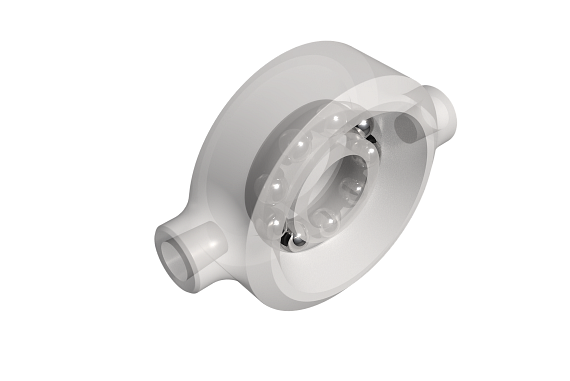 There’s another advantage specific to xiros ball bearings that has yet to be discussed: custom designs. With the amount of freedom possible in overhead conveyor systems, the bearings used need to support that freedom. That’s why igus offers custom ball bearings based upon customers’ own technical drawings or specific application requirements. Additionally, there are no minimum or maximum order quantity limitations, so customers can outfit a system of any size with their custom solution.
There’s another advantage specific to xiros ball bearings that has yet to be discussed: custom designs. With the amount of freedom possible in overhead conveyor systems, the bearings used need to support that freedom. That’s why igus offers custom ball bearings based upon customers’ own technical drawings or specific application requirements. Additionally, there are no minimum or maximum order quantity limitations, so customers can outfit a system of any size with their custom solution.
Conclusion
While there are cases where metal bearings are still preferable to plastic, plastics are capable of performing just as well as, if not better than, metal in applications with low to medium loads and medium speeds. Outside of the improved performance, plastic bearings are also lighter and more cost-effective than metal, and often have a predictable service life to help avoid unplanned downtime.
Learn more about the advantages of plastic ball bearings versus metal ball bearings in our white paper! For questions about a specific product or application related to xiros products, contact a xiros product expert.

